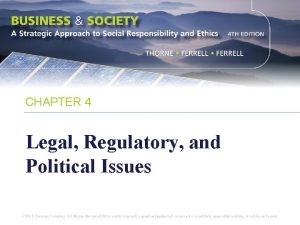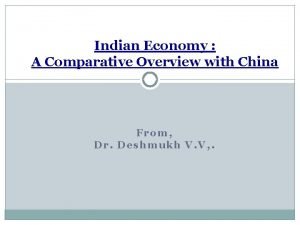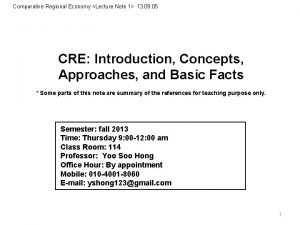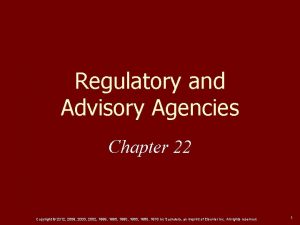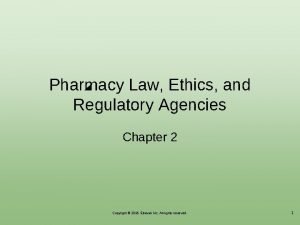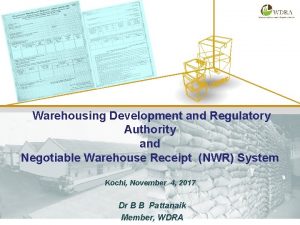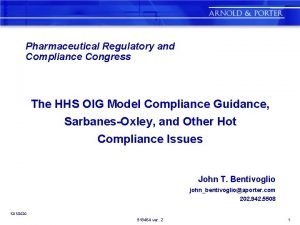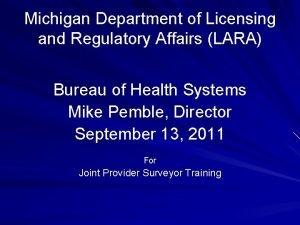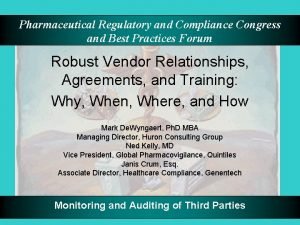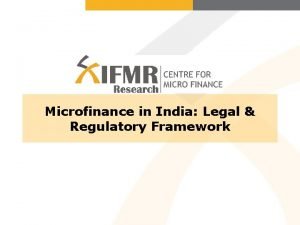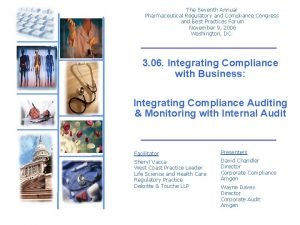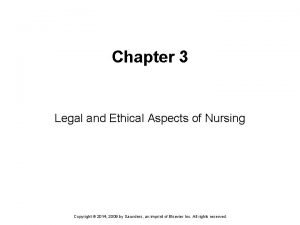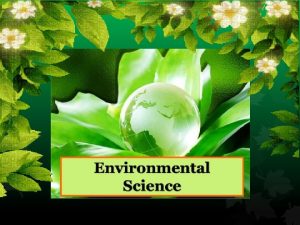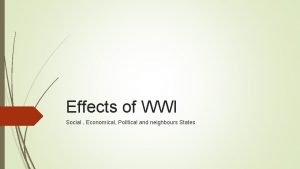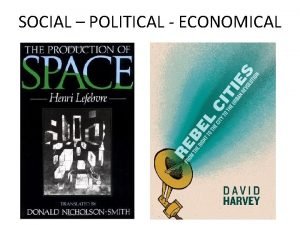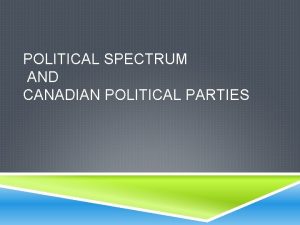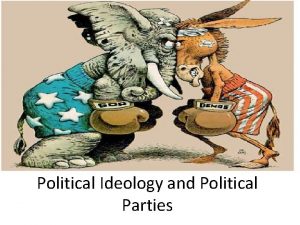Regulatory Political and Economical Aspects As Related to


























- Slides: 26

Regulatory, Political, and Economical Aspects As Related to Sustainable Design of A Biodiesel Facility Prepared for a Senior Chemical Engineering Design Class at UW Seattle, Washington April 6, 2005 Tapas K. Das Washington Department of Ecology Olympia, Washington 98504 E-mail: tdas 461@ecy. wa. gov shivaniki@comcast. net

Areas will be addressed in today’s class • • Regulatory Aspects of Renewable Energy Sources and Biodiesel Governor’s Executive Order for Use of Biodiesel Clean Air Act and Air Quality Standards Geographical and Political Issues Pertinent to Growing Crops and Biodiesel Manufacturing in Washington Environmental and Economical Benefits of Biodiesel Costs (Life Cycle Costs) Define Sustainability - Chemical Engineers’ Perspective Group Discussion, Questions, or Comments

Clean Air Act (CAA) Enacted 1970 Amended 1990 • The CAA is intended to control the emissions of air pollution by establishing uniform ambient air quality standards that are in some instances health-based and in others, technology-based (RACT, BACT, MACT, LAER). • The CAA also address specific air pollution problems such as hazardous air pollutants, stratospheric ozone depletion, and acid rain.

CAA Key Provisions • The CAA established the National Ambient Air Quality Standards (NAAQS) for maximum concentrations in ambient air of CO, NO 2, VOC, SO 2, O 3, PM 10, PM 2. 5, and Pb • States must develop source-specific emission limits to achieve the NAAQS. • States coordinate with adjacent states, local air authority (i. e. , Puget Sound Clean Air Agency in Seattle), and USEPA (Region 10 in Seattle), and issue air emission permits to facilities (i. e. , Prevention of Significant Deterioration (PSD) and New Source Review (NSR) permits) • Stricter requirements are often established for hazardous air pollutant and for new source

Criteria Pollutants Pollutant Description Sources Health Effects Carbon Monoxide (CO) An odorless, tasteless, colorless gas which is emitted primarily from any form of combustionincomplete combustion. Mobile sources (autos, trucks, buses), Wood stoves, Open burning, Industrial combustion sources. Deprives the body of oxygen by reducing the blood’s capacity to carry oxygen; causes headaches, dizziness, nausea, listlessness and in high doses, may cause death. Hydrocarbons (HC) or Reactive Organic Gases Are unburned, partially burnt fuel. Mobile sources (autos, trucks, buses), formed by the incomplete combustion of fuel. When combined with sun light produces photo chemical (smog) Lead (Pb) A widely used metal, which may accumulate in the body. Leaded gasoline, Smelting, Battery manufacturing and recycling. Affects motor function and reflexes and learning; causes damage to the central nervous system, kidneys and brain. Children are affected more than adults. Ozone (O 3) Formed when nitrogen oxides and volatile organic compounds react with one another in the presence of sunlight and warm temperatures. A component of smog. Mobile sources, Industry, Power plants, Gasoline storage and transfer, Paint. Irritates eyes, nose, throat and respiratory system; especially bad for those with chronic heart and lung disease, as well as the very young and old, and pregnant women. Nitrogen Dioxide (NO 2) A poisonous gas produced from nitrogen oxide which is a by-product of sufficiently high burning temperatures. Fossil fuel power, Mobile sources, Industry, Explosives manufacturing, Fertilizer manufacturing. Harmful to lungs, irritates bronchial and respiratory systems; increases symptoms in asthmatic patients. Particulate Matter PM 10 & PM 2. 5 Particles of soot, dust, and unburned fuel suspended in the air. Wood stoves, Industry, Dust, Construction, Street sand application, Open burning. Aggravates ailments such as bronchitis and emphysema; especially bad for those with chronic heart and lung disease, as well as the very young and old, and pregnant women. Sulfur Dioxide (SO 2) A gas resulting from the burning of sulfurcontaining fuel. Fossil fuel power plants, Non-ferrous smelters, Kraft pulp production. Increases symptoms in asthmatic patients; irritates respiratory system.

Air Quality Standards New standards for particulate matter smaller than 2. 5 microns in size (PM 2. 5) and ozone were adopted by EPA in 1997. Pollutant National Primary Carbon Monoxide (CO) Washington State Secondary 8 - Hour Average 9 ppm 1 - Hour Average 35 ppm Lead (Pb) Quarterly Average 1. 5 µg/m 3 Nitrogen Dioxide (NO 2) Annual Average 1. 5 µg/m 3 No standard 0. 053 ppm 0. 05 ppm 1 - Hour Average 0. 12 ppm 8 - Hour Average B 0. 08 ppm No Standard Ozone (O 3) Particulate Matter (PM 10) Annual Arithmetic Mean 50 µg/m 3 24 - Hour Average 150 µg/m 3 Particulate Matter (PM 2. 5) Annual Arithmetic Mean 15 µg/m 3 No Standard 24 -Hour 65 µg/m 3 No Standard

Air Quality Standards, Cont. Sulfur Dioxide (SO 2) Annual Average 0. 03 ppm No Standard 0. 02 ppm 24 - Hour Average 0. 14 ppm No Standard 0. 10 ppm 3 - Hour Average No Standard 0. 50 ppm No Standard 1 - Hour Average No Standard 0. 40 ppm A Total Suspended Particulates Annual Geometric Mean No Standard 60 µg/m 3 24 - Hour Average No Standard 150 µg/m 3 A - 0. 25 not to be exceeded more than two times in any 7 consecutive days. B - Eight hour ozone standard went into effect on September 16, 1997. But implementation is limited. ppm = parts per million µg/m 3 = micrograms per cubic meter Primary standards are listed in this table as they appear in the federal regulations. Ambient concentrations are rounded using the next higher decimal place to determine whether a standard has been exceeded. The data charts in this report are shown with these un rounded numbers. Details of the National Standards are available in 40 CFR Part 50. Online: EPA Air Quality Standards Link to 40 CFR Part 50

Table: Biodiesel Emissions Compared to Petroleum Diesel CARB Pollutants NBB B 100(%) B 20(%) Particulate matter (PM 10) -30 -22 -40 -8 Oxides of nitrogen +13 +2 +6 +1 Polyaromatic hydrocarbon -80 -13 Carbon dioxide -100 -20 Source: California Air Resources Board (CARB); National Biodiesel Board (NBB)

State Implementation Plan (SIP) • The CAA requires states to develop their SIPs that outline how they intend to achieve NAAQS. The SIP-NAAQS system is an example of “State-Federal Joint Efforts” to protect Air Quality. • The Federal government ensures that provisions of CAA are implemented but states are responsible for controlling local sources of air pollution. • When an airshed violates NAAQS for any criteria pollutant, the airshed is designated Nonattainment. Violation would depend on pollutant and averaging time. For example, if the 24 -hr PM 10 standard of 150 μg/m 3 is exceeded more than once per year, the area is designated as nonattainment for PM 10. • SIP establishes control strategy to attain and maintain the NAAQS standards through stricter permit limits, control of area mobile sources, inspection/maintenance program, dust control plan, and other measures.



Executive Order “Establishing Sustainability and Efficiency Goals for State Operations” WHEREAS, sustainability means meeting the needs of current generations without impairing the ability of future generations to meet their own needs, and is an important strategy for the longterm health of the state’s economy, environment and citizens; and WHEREAS, efficiency and cost effectiveness are continuing objectives of state government; and WHEREAS, establishing targets and adopting sustainable building, transportation, paper use and energy use practices will accelerate progress in accomplishing the sustainability goals established in Executive Order 02 -03; and WHEREAS, the use of green building practices can improve employee productivity, improve building operational performance, reduce building operating costs and improve compatibility between the natural and built environments; and WHEREAS, transportation activities are responsible for a majority of the greenhouse gas emissions in Washington state, and state fleets represent an opportunity to decrease greenhouse gas and other toxic emissions as well as achieve operating savings and efficiencies; and WHEREAS, state government can reduce the resource and environmental impacts of paper throughout its lifecycle by changing the way we purchase, use and recycle paper; NOW, THEREFORE, I, Gary Locke, Governor of the State of Washington, declare my commitment that state agencies shall adopt targets and take actions to further the adoption of sustainable practices.

• • Agencies will take all reasonable actions to achieve a target of a 20% reduction in petroleum use from the operation of state vehicles and privately owned vehicles used for state business by September 1, 2009. By September 1, 2009, state agencies will replace standard diesel with a 20% biodiesel blend (B 20). As soon as practicable, agencies will begin using a minimum 5% biodiesel blend (B 5).

Where does biodiesel come from? – In the U. S most biodiesel is made from soy oil. Last year about 30 million gallons of biodiesel was produced, mainly in the mid-west. Passage of the Job Creation Act last fall is expected to up the production of biodiesel to 124 million gallons or more.

Washington Snapshot • Currently about 1 to 1. 5 million gallons of biodiesel is being consumed in Washington, mainly by public fleets. By comparison, about 1 billion gallons of petroleum fuels were consumed in Washington in 2002. • There is currently about 17 biodiesel suppliers in the state and about 20 biodiesel retail outlets. • Seattle Biodiesel began operations this spring and expects to produce about 1 to 2 million gallons per year, with the ability to produce up to 5 million gallons.

There is a growing interest to produce in-state feedstock for biodiesel production from oilseeds - primarily canola and mustard seed. Work is being done to help develop markets for the crush or meal to enhance the market value of oilseeds in order to get farmers to commit to growing oilseed crops. Without these markets, the oil would be too expensive to compete with out of state biodiesel.

A couple of potential projects are under away in Spokane and Columbia counties. Spokane County coops are looking at an integrated project which would include a crusher and a 2. 5 MGY biodiesel plant. Farmers would grow mustard seed as a rotational crop and sell the meal for mustard flour or powder. If this high-value market is realized, they anticipate being able to produce biodiesel at a cost equal or below fossil diesel. Similarly, Columbia County is looking at growing both canola and mustard seed in sufficient quantities to support a 10 million gallons per year plant.

Table: Total Annual Production of US Oils and Fats Vegetable Oil Production (Billion pounds/yr) Soybean 18. 34 Peanuts 0. 22 Sunflower 1. 00 Cottonseed 1. 01 Corn 2. 42 Others 0. 67 Total Veg. Oil 23. 66 Animal Fats (Billion pounds/yr) Edible Tallow 1. 63 Inedible tallow 3. 86 Lard & Grease 1. 31 Yellow Grease 2. 63 Poultry Fat 2. 22 Total Animal Fat 11. 64

Table: Biodiesel Emissions Compared to Petroleum Diesel And Costs CARB Pollutants NBB B 100(%) B 20(%) Particulate matter (PM 10) -30 -22 -40 -8 Oxides of nitrogen +13 +2 +6 +1 Polyaromatic hydrocarbon -80 -13 Carbon dioxide -100 -20 Presently B 100 costs between $1. 25 and $2. 25 per gallons which is pretty competitive with regular gasoline Source: California Air Resources Board (CARB); National Biodiesel Board (NBB)

WHAT IS SUSTAINABILITY? ". . development that meets the needs of the present without compromising the ability of future generations to meet their own needs”* (*) World Commission on the Environment and Development (Brundtland Commission), and “Our Common Future”

Definition of Sustainability • • Sustainability is the action of business in response to Health, Safety, Environmental issues that affect employees, contractors, stakeholders, and the surrounding community. It is a balanced process of taking economic and social benefits with care for the environment and preservation of natural resources (stewardship). Courtesy of: John Carberry, Du. Pont

Figure: Conflicting Objectives of Sustainable Development


What is Industrial Ecology? • A metaphor, emphasizing the need to design industrial systems that mimic the mass conservation and material cycling properties of natural ecosystems. • A new set of systems for chemical engineers to design and optimize, including the integration of chemical processes with industrial sectors (byproduct synergy), and the interaction of anthropogenic emissions and discharges with natural cycles of materials. • A set of design tools to address byproducts synergy (resource recovery and reuse make the entire process more cost-effective; i. e, reuse of crush or meal from biodiesel manufacturing process), and to integrate environmental performance indices into products and process design.

What Have We Learned Today? • Group Discussion • Conclusions

Questions & Comments? Thank you for your attention!
 Legal regulatory and political issues
Legal regulatory and political issues Trade related aspects of intellectual property rights
Trade related aspects of intellectual property rights 2 types of fitness
2 types of fitness What is skill-related fitness? *
What is skill-related fitness? * Three step writing process in business communication
Three step writing process in business communication Agriculture reforms
Agriculture reforms Command economy example
Command economy example Economical comparative and superlative
Economical comparative and superlative Style and tone examples
Style and tone examples Beautiful paradise economical are examples
Beautiful paradise economical are examples Beautiful paradise economical are examples
Beautiful paradise economical are examples Design of steel roof truss
Design of steel roof truss Thousands of possibilities get yours slogan
Thousands of possibilities get yours slogan Chapter 22 regulatory and advisory agencies
Chapter 22 regulatory and advisory agencies Chapter 2 pharmacy law ethics and regulatory agencies
Chapter 2 pharmacy law ethics and regulatory agencies Managing diversity and regulatory challenges
Managing diversity and regulatory challenges Warehouse regulatory and development authority
Warehouse regulatory and development authority Pharmaceutical regulatory and compliance congress
Pharmaceutical regulatory and compliance congress Department of licensing and regulatory affairs
Department of licensing and regulatory affairs Pharmaceutical regulatory and compliance congress
Pharmaceutical regulatory and compliance congress Legal and regulatory framework of microfinance in india
Legal and regulatory framework of microfinance in india Pharmaceutical regulatory and compliance congress
Pharmaceutical regulatory and compliance congress Pharmaceutical regulatory and compliance congress
Pharmaceutical regulatory and compliance congress Chapter 18 visual merchandising and display
Chapter 18 visual merchandising and display Look at pictures and answer the question
Look at pictures and answer the question Legal and ethical aspects in nursing
Legal and ethical aspects in nursing Changing trends in hospital care
Changing trends in hospital care
